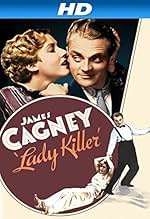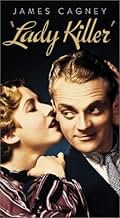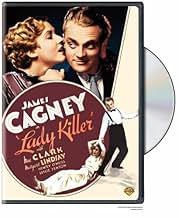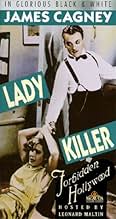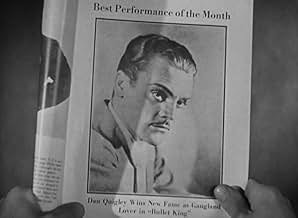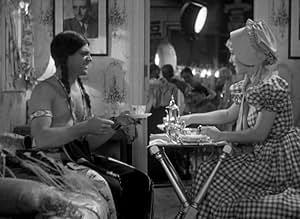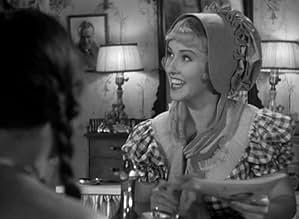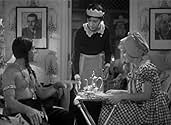AVALIAÇÃO DA IMDb
7,0/10
2,1 mil
SUA AVALIAÇÃO
Adicionar um enredo no seu idiomaA former gangster makes it big in Hollywood, but his old life catches up with him.A former gangster makes it big in Hollywood, but his old life catches up with him.A former gangster makes it big in Hollywood, but his old life catches up with him.
- Direção
- Roteiristas
- Artistas
- Prêmios
- 1 vitória no total
Douglass Dumbrille
- Spade Maddock
- (as Douglas Dumbrille)
William B. Davidson
- Director Williams
- (as William Davidson)
Lowden Adams
- Lois' Butler
- (não creditado)
Luis Alberni
- Director
- (não creditado)
Joseph Belmont
- Monkey Party Guest
- (não creditado)
Brooks Benedict
- Charlie - the Fence
- (não creditado)
Harry Beresford
- Dr. Crane
- (não creditado)
Avaliações em destaque
If you want to know how James Cagney become such a huge star, just watch this - not quite this story about a con man who becomes a Hollywood star but how he outshines the rest of the cast. Even though they are all passable actors, Cagney is somehow in a different league. The downside was that by outshining his co-stars, their contributions make the whole film seem a little amateurish. The upside was that to keep up with him eventually everyone had to get up to his standard but this hadn't quite happened by 1933.
This film is super-fast, super-snappy and both reasonably funny and gripping at the same time. Overseen by Warner's production head Daryl Zanuck, it was written specifically for Cagney to highlight his own particular talents and loveable rogue personality.
Warner Brothers knew exactly what they were doing - making a star and making a lot of money but didn't account for Cagney's demands for staggeringly enormous wages. They did their sums and reluctantly always gave in - just watching him in this you can see why.
This film is super-fast, super-snappy and both reasonably funny and gripping at the same time. Overseen by Warner's production head Daryl Zanuck, it was written specifically for Cagney to highlight his own particular talents and loveable rogue personality.
Warner Brothers knew exactly what they were doing - making a star and making a lot of money but didn't account for Cagney's demands for staggeringly enormous wages. They did their sums and reluctantly always gave in - just watching him in this you can see why.
Look out, world! Jimmy Cagney's coming to Hollywood and whether they use bullets or make-up the con artists haven't got a chance, in this raucous send-up featuring a New York crime boss who lands himself where the real action is – on a theater marquee.
Cagney is a wise guy named Dan Quigley who can't make it as a movie usher, so he raises his sights from lavatory dice games to breaking into rich folks' homes with the help of a nasty gang. When that goes bad and the gang leaves him flat, Quigley finds a new line in Hollywood, first as an extra, soon after as a "Famous He-Man of the Screen." But what will happen when the old gang shows up for a piece of the action?
The marquee in lights near the start of the film advertises someone called "The Prince Of Pep." He might as well be Cagney in this streamlined star vehicle, written entirely to showcase his fast patter and easy charm. Cagney's so good they don't even bother to build a coherent film around his character, and it hardly matters.
If you want to see a great Cagney film, there are perhaps a couple dozen better candidates. But if you want to see why the guy clicked so hard in the days of early sound, and still packs a punch 80 years later, this should be on your short list.
Cagney's lines here are priceless. To a dog being held by a theater manager who just fired him: "Listen, Fido, this guy's got a wooden leg. Try it sometime!"
To a group of card sharps who just cleaned him out: "I think I'll stick to checkers."
To the same group, after he's figured out their scam: "You kick back with my fifty bucks, or I'll fold your joint like an accordion!"
Just seconds later, he proposes a partnership. "You got a sweet racket here. Maybe I can show you a few new wrinkles."
"Lady Killer" was made just before the Hays Code was seriously enforced, which makes for interesting viewing. Reviewers here have already pointed out a scene when we see Quigley sneak Mae Clarke's character Myra a peck on the breast. The film takes even greater advantage of the liberal mores then still in effect by letting Quigley get away with his crimes. Sure, he goes straight, sort of, but only because he finds a better racket than potentially homicidal B&Es. There's no moment of Quigley coming to regret his wicked past, as censors would have required just months later.
That makes for a more entertaining Cagney vehicle, but a somewhat disjointed film. Director Roy Del Ruth keeps things moving quick, but in odd directions in tone, turning "Lady Killer" from a semi-serious gangster story to a genially goofy Hollywood satire. In his DVD commentary, Drew Casper calls "Lady Killer" a "shyster satire." It might also be called a "crooked comedy;" no one is on the level, whichever side of the law they're on.
So in Hollywood, we see Quigley break big after really slugging an extra in a mock prison break scene, and further his path toward stardom by faking fan letters. It's shallow stuff, but fun, especially as it all plays so fast. Other than the star, pacing is "Lady Killer's" ace in the hole.
Clarke should have graduated from the grapefruit league with this performance. She and Cagney resume their fireworks from "Public Enemy," this time with even more outrageous stunts, but Clarke, here the first- billed female, does wise work making sure we enjoy her comeuppance. Even her catty asides to Cagney, or the way she shamelessly plays with her hair while shaking him down for (more) dough, is on par with Barbara Stanwyck's star-making wickedness.
But make no mistake, "Lady Killer" is Cagney's baby, and he makes it work, despite the tone shifts and the odd title (Quigley's not a killer himself, and doesn't play with women's affections). You root for the guy despite his crookedness, and that's all that matters in the end.
Cagney is a wise guy named Dan Quigley who can't make it as a movie usher, so he raises his sights from lavatory dice games to breaking into rich folks' homes with the help of a nasty gang. When that goes bad and the gang leaves him flat, Quigley finds a new line in Hollywood, first as an extra, soon after as a "Famous He-Man of the Screen." But what will happen when the old gang shows up for a piece of the action?
The marquee in lights near the start of the film advertises someone called "The Prince Of Pep." He might as well be Cagney in this streamlined star vehicle, written entirely to showcase his fast patter and easy charm. Cagney's so good they don't even bother to build a coherent film around his character, and it hardly matters.
If you want to see a great Cagney film, there are perhaps a couple dozen better candidates. But if you want to see why the guy clicked so hard in the days of early sound, and still packs a punch 80 years later, this should be on your short list.
Cagney's lines here are priceless. To a dog being held by a theater manager who just fired him: "Listen, Fido, this guy's got a wooden leg. Try it sometime!"
To a group of card sharps who just cleaned him out: "I think I'll stick to checkers."
To the same group, after he's figured out their scam: "You kick back with my fifty bucks, or I'll fold your joint like an accordion!"
Just seconds later, he proposes a partnership. "You got a sweet racket here. Maybe I can show you a few new wrinkles."
"Lady Killer" was made just before the Hays Code was seriously enforced, which makes for interesting viewing. Reviewers here have already pointed out a scene when we see Quigley sneak Mae Clarke's character Myra a peck on the breast. The film takes even greater advantage of the liberal mores then still in effect by letting Quigley get away with his crimes. Sure, he goes straight, sort of, but only because he finds a better racket than potentially homicidal B&Es. There's no moment of Quigley coming to regret his wicked past, as censors would have required just months later.
That makes for a more entertaining Cagney vehicle, but a somewhat disjointed film. Director Roy Del Ruth keeps things moving quick, but in odd directions in tone, turning "Lady Killer" from a semi-serious gangster story to a genially goofy Hollywood satire. In his DVD commentary, Drew Casper calls "Lady Killer" a "shyster satire." It might also be called a "crooked comedy;" no one is on the level, whichever side of the law they're on.
So in Hollywood, we see Quigley break big after really slugging an extra in a mock prison break scene, and further his path toward stardom by faking fan letters. It's shallow stuff, but fun, especially as it all plays so fast. Other than the star, pacing is "Lady Killer's" ace in the hole.
Clarke should have graduated from the grapefruit league with this performance. She and Cagney resume their fireworks from "Public Enemy," this time with even more outrageous stunts, but Clarke, here the first- billed female, does wise work making sure we enjoy her comeuppance. Even her catty asides to Cagney, or the way she shamelessly plays with her hair while shaking him down for (more) dough, is on par with Barbara Stanwyck's star-making wickedness.
But make no mistake, "Lady Killer" is Cagney's baby, and he makes it work, despite the tone shifts and the odd title (Quigley's not a killer himself, and doesn't play with women's affections). You root for the guy despite his crookedness, and that's all that matters in the end.
"Lady Killer" represents a combination of talents Hollywood will never see again. There is fast talking James Cagney, who starts the movie as a dice playing, gum chewing usher who makes wise guy, but funny, comments to everyone. In Cagney's opening scene, he just makes it to a count out of the 25 ushers, held on the roof of the movie theater they work at. All wear Warner Bros. uniforms, including a cap with the WB logo on it. As Cagney advances in life, he becomes a partner in a gambling operation. One of his confederates slugged too hard a maid and almost kills her during a home robbery, another criminal activity Cagney's gang is involved in. Cagney tells the confederate (played by a snarling Leslie Fenton), what does he think, the police are dumbbells. Dumbbell was a favorite word of screenwriter Ben Markson, who used it to good advantage in another movie he co-wrote, "Gold Diggers of 1933."
Roy Del Ruth does his usual super job, cramming a ton of action into 76 minutes. There is one scene,where the cab of Mae Clarke's character is stopped at one of those old traffic devices, which has two signal vanes, one marked stop, and the other go. The stop signal goes up, another of Cagney's partners,Douglas Dumbrille, happens to be in the adjacent cab, he gets into Clarke's. He tells her "things are plenty hot in New York, I just jumped my bail and beat it out here by plane," to Los Angeles.
Meanwhile, Cagney is being questioned by the LA police, who previously picked him up at the train station on a New York warrant. Cagney tells the police chief, he went West for the climate, on account of his asthma. This scene represents the first mention I know of asthma in a mainstream movie. Later, after Cagney is sprung loose, Brannigan, the cop (played by Robert Elliot, almost typecast to cop roles in the 30s) who first pulled him in at the train station, tells him that if he doesn't find a job, he will be picked up as a "vag" (for vagrant) and get 30 days in jail.
When you look at this scene, notice the outline of the Venetian blinds on the office wall, and the dark shadows falling on the the faces of the Chief, Brannigan and Cagney's character. This scene, and the subsequent scene of Cagney trying to keep a low profile in a pool hall, unshaven and furtive, look as if they were from a film noir movie, only these scenes were made more than 12 years before the film noir cycle started.
The scenes showing Cagney working as a movie extra show how movies were made in the early 1930s, at least according to Roy Del Ruth. There is a scene of Cagney as an Indian chief on an imitation horse riding in front of a back projection screen, the movie director shouting, with a heavy European accent, "Ride, That A Boy!" Later, on a 15 minute lunch break, box lunch in hand, Cagney identifies himself to his future girlfriend, Margaret Lindsay as a Chief with the name, said in Yiddish, Pain In The Ass. I could be off in the translation, but Cagney used a Yiddish phrase.
The movie plot has one unexpected connection to real life. In 1939, there was a New York gangster named Greenbaum, nicknamed "Big Greenie." As I recall, from reading Burton Turkus's book, "Murder, Inc." years ago, Greenbaum fled to the West Coast, where he worked as an extra in movies while avoiding Lepke's killers. Greenbaum knew too much, and Lepke eventually managed to have "Big Greenie" killed.
"Lady Killer" was made in 1933 fast, by great talents. I saw it playing the laserdisc of the movie, part of the double laserdisc of James Cagney movies that Image released in 1992. The second movie on the LD set, "Blonde Crazy," made in 1931, is good also, but the advances made in movie making in two years are really something, comparing the two movies.
There is only one slight flaw in "Lady Killer." In every other pre-Code movie I saw from Warner Bros., when someone reads a telegram, you see the telegram message on screen, the telegram made by the prop department. When the LA police chief shows a telegram to Cagney, explaining the situation, he tells him New York authorities asked him to hold Cagney's character. You never see the actual telegram message, Warners usual practice then, a practice not usually followed by other studios. Maybe Warners' prop department did prepare a fictitious telegram but movie director Roy Del Ruth thought it looked "fakey."
Roy Del Ruth does his usual super job, cramming a ton of action into 76 minutes. There is one scene,where the cab of Mae Clarke's character is stopped at one of those old traffic devices, which has two signal vanes, one marked stop, and the other go. The stop signal goes up, another of Cagney's partners,Douglas Dumbrille, happens to be in the adjacent cab, he gets into Clarke's. He tells her "things are plenty hot in New York, I just jumped my bail and beat it out here by plane," to Los Angeles.
Meanwhile, Cagney is being questioned by the LA police, who previously picked him up at the train station on a New York warrant. Cagney tells the police chief, he went West for the climate, on account of his asthma. This scene represents the first mention I know of asthma in a mainstream movie. Later, after Cagney is sprung loose, Brannigan, the cop (played by Robert Elliot, almost typecast to cop roles in the 30s) who first pulled him in at the train station, tells him that if he doesn't find a job, he will be picked up as a "vag" (for vagrant) and get 30 days in jail.
When you look at this scene, notice the outline of the Venetian blinds on the office wall, and the dark shadows falling on the the faces of the Chief, Brannigan and Cagney's character. This scene, and the subsequent scene of Cagney trying to keep a low profile in a pool hall, unshaven and furtive, look as if they were from a film noir movie, only these scenes were made more than 12 years before the film noir cycle started.
The scenes showing Cagney working as a movie extra show how movies were made in the early 1930s, at least according to Roy Del Ruth. There is a scene of Cagney as an Indian chief on an imitation horse riding in front of a back projection screen, the movie director shouting, with a heavy European accent, "Ride, That A Boy!" Later, on a 15 minute lunch break, box lunch in hand, Cagney identifies himself to his future girlfriend, Margaret Lindsay as a Chief with the name, said in Yiddish, Pain In The Ass. I could be off in the translation, but Cagney used a Yiddish phrase.
The movie plot has one unexpected connection to real life. In 1939, there was a New York gangster named Greenbaum, nicknamed "Big Greenie." As I recall, from reading Burton Turkus's book, "Murder, Inc." years ago, Greenbaum fled to the West Coast, where he worked as an extra in movies while avoiding Lepke's killers. Greenbaum knew too much, and Lepke eventually managed to have "Big Greenie" killed.
"Lady Killer" was made in 1933 fast, by great talents. I saw it playing the laserdisc of the movie, part of the double laserdisc of James Cagney movies that Image released in 1992. The second movie on the LD set, "Blonde Crazy," made in 1931, is good also, but the advances made in movie making in two years are really something, comparing the two movies.
There is only one slight flaw in "Lady Killer." In every other pre-Code movie I saw from Warner Bros., when someone reads a telegram, you see the telegram message on screen, the telegram made by the prop department. When the LA police chief shows a telegram to Cagney, explaining the situation, he tells him New York authorities asked him to hold Cagney's character. You never see the actual telegram message, Warners usual practice then, a practice not usually followed by other studios. Maybe Warners' prop department did prepare a fictitious telegram but movie director Roy Del Ruth thought it looked "fakey."
Lady Killer (1933)
I love these multi-part stories, where one set of scenes shifts to a whole new set, and then they eventually intertwine. And I also love movies that show the inside of Hollywood, with actual recreations of movie sets and movie shoots.
Lady Killer has both, and James Cagney, too. It's fast, furious, funny, and shot with a bright, glinting intelligence. Not quite a gangster film, it does have crime and some crooked thugs. And not quite a comedy, it pulls out quite a few laughs, mostly because Cagney is a card. There are two fabulous first ladies (and they naturally must view for our man), Mae Clark and Margaret Lindsay, and a slew of second men who hold up their characters with caricature.
In all, there is no Warner message here, except maybe the virtue can sometimes prevail. It's just a lot of great scenes, witty dialog, and a play of good guys against bad guys. Look for some stunning rain scenes in California (yeah, I know), and for a huge range of interior and exterior set ups, fairly elaborate for Warner Bros. budgets.
For Cagney fans, it's a riot to see him take on, briefly, a series of roles as Indian chief, Italian lover, and prisoner on work detail. The latter, of course, is close to the real roles that made him famous, and his role here is actually a little lighter than that, a bad guy who is all wisecracks and cheerfulness. Look for some insider jokes, like the poster (and mention) of the Edward G. Robinson film, and the movie ushers wearing hats all with the Warner Brothers logo on it.
Great stuff. I loved it even as I knew it wasn't quite a masterpiece. Oh, and the new (2010) Warner DVD is sparkling, a first rate print!
I love these multi-part stories, where one set of scenes shifts to a whole new set, and then they eventually intertwine. And I also love movies that show the inside of Hollywood, with actual recreations of movie sets and movie shoots.
Lady Killer has both, and James Cagney, too. It's fast, furious, funny, and shot with a bright, glinting intelligence. Not quite a gangster film, it does have crime and some crooked thugs. And not quite a comedy, it pulls out quite a few laughs, mostly because Cagney is a card. There are two fabulous first ladies (and they naturally must view for our man), Mae Clark and Margaret Lindsay, and a slew of second men who hold up their characters with caricature.
In all, there is no Warner message here, except maybe the virtue can sometimes prevail. It's just a lot of great scenes, witty dialog, and a play of good guys against bad guys. Look for some stunning rain scenes in California (yeah, I know), and for a huge range of interior and exterior set ups, fairly elaborate for Warner Bros. budgets.
For Cagney fans, it's a riot to see him take on, briefly, a series of roles as Indian chief, Italian lover, and prisoner on work detail. The latter, of course, is close to the real roles that made him famous, and his role here is actually a little lighter than that, a bad guy who is all wisecracks and cheerfulness. Look for some insider jokes, like the poster (and mention) of the Edward G. Robinson film, and the movie ushers wearing hats all with the Warner Brothers logo on it.
Great stuff. I loved it even as I knew it wasn't quite a masterpiece. Oh, and the new (2010) Warner DVD is sparkling, a first rate print!
When you think of James Cagney, you think of a gangster in films like The Public Enemy, where he smashed that grapefruit into Mae Clarke's face. But Cagney won his Oscar for Yankee Doodle Dandy. He also received nominations for Angels With Dirty Faces and Love Me or Leave Me.
Here he shows just how far his range extends in a romantic comedy which also includes Mae Clarke in a bigger role than you are probably accustomed to seeing her. There is a lot of action in this 76 minute film. Cagney is a theater usher who gets fired and ends up following Mae as she is trolling for suckers to get fleeced by her partners in a card game. He joins the group and they pull bigger more sophisticated cons until a trigger happy gang member kills a servant during a home robbery.
He and Mae head to Los Angeles, and when the LA police hold him for what happened in New York, Myra and one of the gang make off with Cagney's money. The LA police ultimately have to let him go, but penniless he gets increasingly shaggy and ragged looking. This causes him to get picked up for a series of bit parts by a local movie crew exactly because of his scruffy looks. One of the fascinating bits here is seeing how movies were made at the time. He hooks up with star Margaret Lindsay and uses his conning skills to make himself a star. (As an aside, Lindsey made 12 films that year, her second year as an actress.)
Soon, Mae and the gang find him and they want to pick up where they left off, using Cagney to get into posh places that they can rob. He tries to get them out of town, but they see dollars in LA and are going nowhere. How will this all work out? Watch and find out. And like I said, there's a lot of action for 76 minutes and Cagney really shows he can do romance, comedy, and gangster all in one film.
Here he shows just how far his range extends in a romantic comedy which also includes Mae Clarke in a bigger role than you are probably accustomed to seeing her. There is a lot of action in this 76 minute film. Cagney is a theater usher who gets fired and ends up following Mae as she is trolling for suckers to get fleeced by her partners in a card game. He joins the group and they pull bigger more sophisticated cons until a trigger happy gang member kills a servant during a home robbery.
He and Mae head to Los Angeles, and when the LA police hold him for what happened in New York, Myra and one of the gang make off with Cagney's money. The LA police ultimately have to let him go, but penniless he gets increasingly shaggy and ragged looking. This causes him to get picked up for a series of bit parts by a local movie crew exactly because of his scruffy looks. One of the fascinating bits here is seeing how movies were made at the time. He hooks up with star Margaret Lindsay and uses his conning skills to make himself a star. (As an aside, Lindsey made 12 films that year, her second year as an actress.)
Soon, Mae and the gang find him and they want to pick up where they left off, using Cagney to get into posh places that they can rob. He tries to get them out of town, but they see dollars in LA and are going nowhere. How will this all work out? Watch and find out. And like I said, there's a lot of action for 76 minutes and Cagney really shows he can do romance, comedy, and gangster all in one film.
Você sabia?
- CuriosidadesFor the scene when Dan Quigley hauls Myra Gale across the apartment floor by her hair and throws her out the door, James Cagney taught his co-star Mae Clarke an old stage trick. When Cagney grabbed hold of Clarke's hair (holding her by the top of her head), Clarke reached up and grabbed Cagney's wrist with both hands. This put her weight on Cagney's wrist, instead of on her hair. Clarke then held on to Cagney's wrist, screaming, as he dragged her across the room.
- Erros de gravaçãoAfter the robbery of the wealthy woman's home, the paper says a maid was struck and seriously injured, and later in Dan Quigley's office, they're still talking about a maid who screams. Later, when the guy who actually hit her comes back scared, he says the butler died.
The owner of the house where Dan was taken after the "car accident" was Mrs. Wilbur Marley. This was the house where the maid was "slugged". The butler who "croaked" was "on the Crosby job".
- Citações
Spade Maddock: [discussing diamond-studded Mrs. Marley at the gang's speakeasy] C'mere - take a gander at her.
Dan Quigley: [eyeing her through a peephole] Did you say "gander?" I wonder how she'd go for a goose.
- ConexõesFeatured in Hollywood: The Great Stars (1963)
- Trilhas sonorasIsn't It Heavenly
(1933) (uncredited)
Music by Joseph Meyer
Lyrics by E.Y. Harburg
Played when Myra invites Dan into her apartment.
Principais escolhas
Faça login para avaliar e ver a lista de recomendações personalizadas
- How long is Lady Killer?Fornecido pela Alexa
Detalhes
- Data de lançamento
- País de origem
- Idiomas
- Também conhecido como
- Lady Killer
- Locações de filme
- Hinman Hotel, 7th Street and Figueroa Street, Los Angeles, Califórnia, EUA(The opening scene with the theater manager addressing his ushers in military formation is filmed on the rooftop of this hotel building)
- Empresa de produção
- Consulte mais créditos da empresa na IMDbPro
- Tempo de duração1 hora 16 minutos
- Cor
- Mixagem de som
- Proporção
- 1.37 : 1
Contribua para esta página
Sugerir uma alteração ou adicionar conteúdo ausente


